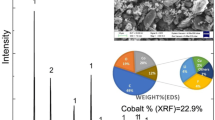Abstract
Effective mechanical treatment of end-of-life lithium-ion batteries (LIBs) to recover a high yield of enriched active electrode materials (i.e., lithium metal oxide and graphite) is key to achieving a robust LIB recycling process. In this study, shredding and sieving were performed on LIB packs of three cell types (prismatic, cylindrical, and pouch cells) to investigate the separation and liberation of LIB components. The results demonstrated that a significant portion of lithium metal oxide remained unliberated from the aluminum foil after shredding. Of the physical liberation methods investigated, it was shown that attrition milling of shredded LIB packs effectively separated LIB components, and enriched active materials, metal foils and low-value components into < 500 μm, 500 μm to 2 mm, and > 2 mm fractions, respectively. A combination of shredding, sieving, and attrition milling was demonstrated to be a promising mechanical/physical method for liberation and beneficiation of LIB components.






Similar content being viewed by others
References
C. Curry, Lithium-Ion Battery Costs and Market (2017). https://data.bloomberglp.com/bnef/sites/14/2017/07/BNEF-Lithium-ion-batterycosts-and-market.pdf. Accessed 18 August 2019.
C. Helbig, A.M. Bradshaw, L. Wietschel, A. Thorenz, and A. Tuma, J. Clean. Prod. 172, 274 (2018).
B. Moradi and G.G. Botte, J. Appl. Electrochem. 46, 123 (2016).
D.H.P. Kang, M. Chen, and O.A. Ogunseitan, Environ. Sci. Technol. 47, 5495 (2013).
X. Zeng, J. Li, and N. Singh, Crit. Rev. Environ. Sci. Technol. 44, 1129 (2014).
F. Larsson, P. Andersson, P. Blomqvist, and B.E. Mellander, Sci. Rep. 7, 1 (2017).
D.A. Notter, M. Gauch, R. Widmer, P. Wager, A. Stamp, R. Zah, and H.-J. Althaus, Environ. Sci. Technol. 44, 6550 (2010).
J. Dewulf, G. Van der Vorst, K. Denturck, H. Van Langenhove, W. Ghyoot, J. Tytgat, and K. Vandeputte, Resour. Conserv. Recycl. 54, 229 (2010).
J. Heelan, E. Gratz, Z. Zheng, Q. Wang, M. Chen, D. Apelian, and Y. Wang, JOM 68, 2632 (2016).
F. Gu, J. Guo, X. Yao, P.A. Summers, S.D. Widijatmoko, and P. Hall, J. Clean. Prod. 161, 765 (2017).
D. Cheret and S. Santen, U.S. Patent No. 7,169,206 (2007).
F. Saloojee and J. Lloyd, Lithium Battery Recycling Process. Department of Environmental Affairs Development Bank of South Africa (Project No. DB-074 (RW1/1016)) (2015).
T. Georgi-Maschler, B. Friedrich, R. Weyhe, H. Heegn, and M. Rutz, J. Power Sources 207, 173 (2012).
B. Yazicioglu and J. Tytgat, DG Environment–Stakeholder Meeting, (Umicore, 2011). https://ec.europa.eu/environment/waste/batteries/pdf/umicore_pres_18072011.pdf. Accessed 12 Mar 2018.
A. Sonoc, J. Jeswiet, and V.K. Soo, Proc. CIRP 29, 752 (2015).
T. Zhang, Y. He, F. Wang, L. Ge, X. Zhu, and H. Li, Waste Manag 34, 1051 (2014).
J. Diekmann, C. Hanisch, L. Froböse, G. Schälicke, T. Loellhoeffel, A.-S. Fölster, and A. Kwade, J. Electrochem. Soc. 164, A6184 (2016).
F. Pagnanelli, E. Moscardini, P. Altimari, T. Abo Atia, and L. Toro, Waste Manag 60, 706 (2017).
S.M. Shin, N.H. Kim, J.S. Sohn, D.H. Yang, and Y.H. Kim, Hydrometallurgy 79, 172 (2005).
X. Wang, G. Gaustad, and C.W. Babbitt, Waste Manag 51, 204 (2016).
L. Wuschke, H. Jäckel, T. Leißner, and U.A. Peuker, Waste Manag 85, 317 (2019).
T. Boundy, M. Boyton, and P. Taylor, J. Clean. Prod. 154, 436 (2017).
J. Li, P. Shi, Z. Wang, Y. Chen, and C.C. Chang, Chemosphere 77, 1132 (2009).
L. Li, L. Zhai, X. Zhang, J. Lu, R. Chen, F. Wu, and K. Amine, J. Power Sources 262, 380 (2014).
L.P. He, S.Y. Sun, X.F. Song, and J.G. Yu, Waste Manag 46, 523 (2015).
C.G. Barlowz, Electrochem. Solid-State Lett. 2, 362 (1999).
Acknowledgements
The authors would like to thank Ruben Ochoa for assistance with equipment fabrication, mechanical experiments, and material analysis related to this work. The University of Utah Waste Management Center provided batteries for this study.
Author information
Authors and Affiliations
Corresponding author
Additional information
Publisher's Note
Springer Nature remains neutral with regard to jurisdictional claims in published maps and institutional affiliations.
Electronic supplementary material
Below is the link to the electronic supplementary material.
Rights and permissions
About this article
Cite this article
Pinegar, H., Smith, Y.R. End-of-Life Lithium-Ion Battery Component Mechanical Liberation and Separation. JOM 71, 4447–4456 (2019). https://doi.org/10.1007/s11837-019-03828-7
Received:
Accepted:
Published:
Issue Date:
DOI: https://doi.org/10.1007/s11837-019-03828-7




